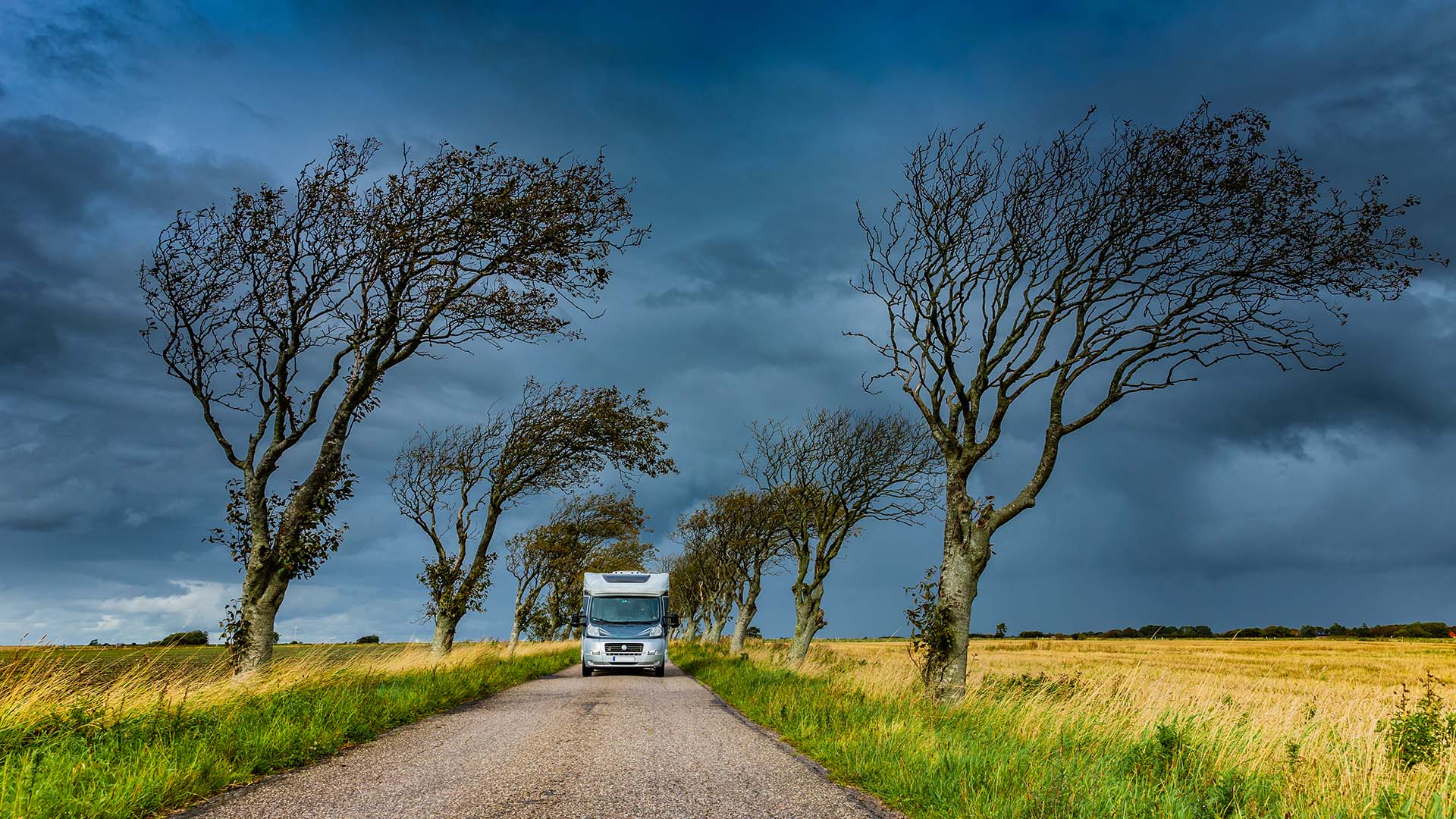- Advice
- Camping Tips
- Camping in Wind
Advice and Tips for Camping in Strong Winds
Camping in strong winds can be intimidating, especially if you are not prepared. Our blog will take you through helpful tips and practical advice on how to stay safe, comfortable, and confident when the weather turns rough.
Best equipment for camping in strong winds

Preparation is the key to enjoying your trip even when strong winds are expected. Here are some ways to make sure you are ready before you head out.
Purchase a wind-resistant tent
If you’re camping in colder months or in areas prone to strong winds, consider investing in a four-season tent or mountaineering tent designed to handle extreme weather. A smaller, low-profile tent is usually the best choice, as its shape offers less surface area for the wind to catch.
It’s also worth considering an air-beam tent. These use inflatable beams instead of traditional poles, making them more flexible in strong gusts. They won’t snap like rigid poles can, and if a beam does lose pressure, it can simply be reinflated.
Whichever style you choose, make sure your tent has strong structural support, reinforced seams, and multiple guyline attachment points. These features will help keep it stable and securely anchored, reducing the risk of it shifting or blowing away in high winds.
For more guidance on the different tent types, check out our Expert Guide on Buying a Tent.
Pack these essentials for windy weather
When camping in windy conditions, packing the right gear can make a big difference in your comfort and safety. Be sure to include:
- Warm layers: To stay insulated and comfortable when temperatures drop.
- Waterproof clothing: Wet clothes can make you feel much colder, so waterproof layers help keep you dry and warm even in strong winds or rain.
- Tent repair kit: Essential for quick fixes if gusts of wind damage your tent.
- Eye protection: Glasses or sunglasses help keep sand, dirt, and debris out of your eyes.
- Earplugs: Strong winds can be loud at night, and earplugs can help you sleep better.
- Sturdy backpack: A reliable backpack keeps your belongings secure and makes carrying your load easier, even in rough weather.
- First aid kit: It’s always helpful to have one on hand in case of minor accidents or injuries.
- Woolly hat and scarf: Covering your ears and face helps retain heat and shields you from harsh winds.
- Hair ties: Beneficial for anyone with long hair. Hair ties prevent your hair from tangling and keep it out of your face when the wind is strong. TIP: Braiding your hair will keep it all in place and create fewer knots.
- Entertainment: If the weather turns bad, packing books, games, or other activities will keep you entertained while indoors.
For more camping essentials, check out our Ultimate Camping Checklist.
How to pitch a tent in strong winds?

Pitching a tent in strong winds can be challenging, especially when the elements are working against you. To prevent your tent from turning into an oversized kite, here are some practical tips for setting up camp safely in windy conditions.
1. Find a safe spot to pitch
Whether you have the option to choose your pitch or not, keep these tips in mind when selecting a safe spot to pitch your tent.
- Avoid exposed locations: Open and elevated areas such as beaches, ridges, and hilltops tend to have stronger, harsher winds. Choose a more sheltered location whenever possible.
- Use a natural windbreak: Look for boulders, bushes, or small hills that can act as natural windbreaks. These features help block the harsh winds from reaching your tent.
- Stay clear of trees: Although trees can offer some shelter, they also pose a risk. Strong winds can cause branches to fall, potentially damaging your tent or causing injury.
- Pitch behind your car: If you have a car, set up your tent a metre or two behind your vehicle and use it as a windbreak.
- Avoid pitching near free-standing objects: Stay away from signposts, bins, or any loose structures that could be blown over and hit your tent.
2. Position your tent correctly
When pitching your tent in windy conditions, the way you position it can make a big difference. Here are some handy tips to remember:
- Face the narrow end of the tent in the direction of the wind: This allows the tent to cut through gusts rather than taking the full force of the wind on its side.
- Position the doors away from the wind: This helps prevent gusts from blowing inside, improves stability, and makes it easier to get in and out without struggling against strong winds.
3. Secure your tent properly
When pitching your tent in strong winds, it’s essential to secure it well to prevent it from blowing away. Here are some helpful tips to keep your tent in place.
- Add extra guylines and tent pegs: Using additional guylines and pegs provides extra stability and anchors your tent more firmly to the ground.
- Hammer in pegs at 45 degrees: Inserting pegs at a slight angle away from the tent increases their holding strength and helps prevent guylines from loosening or detaching.
- Distribute weight evenly: Once your tent is pitched, place heavier items such as backpacks or camping gear at each corner. This helps keep the tent anchored and prevents it from shifting in strong winds.
- Secure the tents’ rainfly: In windy conditions, a properly attached rainfly helps your tent handle the wind efficiently, adds an extra layer of protection from rain and debris, and improves overall stability. Make sure it’s tightly secured to guylines or anchor points so it stays in place.
How to secure a caravan or motorhome in strong winds?

Strong winds can also be dangerous for caravans and motorhomes if they are not properly secured. Here are practical tips to keep your vehicle stable and safe:
1. Pitch up in a sheltered area
If possible, park your caravan or motorhome behind a wall, building, or hill. Natural windbreaks reduce exposure to strong gusts and improve overall stability.
2. Face the vehicle in the direction of the wind
Position your vehicle so it faces the wind head-on. This reduces swaying and helps the vehicle withstand strong gusts effectively.
3. Take down awnings and porches
Remove any awnings, porches, or other extensions before high winds arrive. These structures can act like sails, placing extreme stress on your vehicle.
4. Pack away any outdoor furniture
Pack away all outdoor camping equipment, including chairs, tables, stoves, hammocks, or decorative items. Loose items can be dangerous for you, other campers and wildlife.
5. Use storm straps or tie-downs
Where possible, attach storm straps or tie-downs to anchor the caravan or motorhome. This helps prevent movement and adds stability during strong gusts of wind.
6. Place heavy items in the centre of your unit
Heavy items like water containers, luggage, or appliances should be placed near the centre of your vehicle as it lowers the vehicle's centre of gravity and reduces the risk of it tipping or swaying.
How to stay safe when camping in the wind?

Strong winds can make camping challenging and, in some cases, dangerous. Knowing how to respond and take precautions can keep you safe. Here are some essential tips to help you manage windy conditions at your campsite and beyond.
1. Monitor the weather forecast
Check local weather reports before and during your trip to stay aware of changing wind conditions. Being prepared allows you to adjust your plans and avoid unnecessary risk.
2. Stay in your camping unit
Avoid leaving your tent, caravan, or motorhome unattended in strong winds. It’s worth having some indoor entertainment so you can keep yourself busy.
3. Avoid open flames
Strong gusts can spread fire quickly, so keep open flames away from your camping unit—especially tents, which are highly flammable.
4. Seek shelter if winds become too strong
If weather conditions get worse, move to a solid structure such as a building, or if you’re tent camping, shelter in your car. If the wind becomes too strong, leave the campsite entirely. Safety should always come first.
